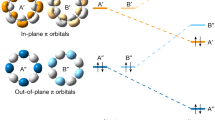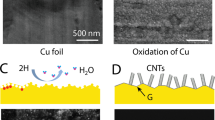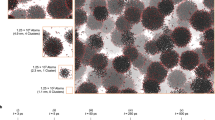Carbon deposition under extreme conditions causes tree-like structures to spring up.
Abstract
The complex deposition and growth of graphitic carbon has come up with several surprises in recent years, including the growth of fullerenes and carbon nanotubes1. Here we describe the spectacular growth of micron-sized tree-like carbon structures produced by chemical vapour deposition of methane without the use of any catalysts. Our results show that carbon surfaces can be tailored while they are growing simply by controlling the rate of deposition from the vapour phase.
Similar content being viewed by others
Main
The remarkable growth of carbon trees occurs autocatalytically, through the restructuring of newly deposited carbon surfaces. Figure 1 shows an overview of carbon trees of varying heights formed on graphite electrodes. The trees taper outwards from the surface and the stalks have the shape of narrow inverted cones. Growth proceeds during many intermittent cycles in what we call a ‘flash CVD’ process.
Flash CVD involves fast resistive heating of graphite electrodes in an atmosphere of methane and helium at a total pressure of 500 torr. The temperature of the heated zone on the electrodes, where the trees grow, ranges between 1,100 and 2,200 °C. During each cycle (lasting about 30 seconds), heating occurs extremely rapidly at rates of several hundred degrees centigrade per second. Trees nucleate during different cycles, but growth continues at all cycles at an average rate of 200 μm min−1 ( Fig. 1). The diameter of the smallest tree we observed was about 100 nm.
What stimulates this unusual growth of carbon structures from plain graphite surfaces? During the CVD flashes, carbon deposits from the vapour phase as a new graphitic surface with a strong spherulitic (pyrolitic graphite structure) morphology2. During growth, several spherulitic nodules that are almost spherical in shape (Fig. 2a) emerge out of the surface. An explanation for this is the fact that the nodules (made of turbostratic graphite layers) are misorientated with respect to each other, and so the rotation of planes at the nodule–nodule interfaces is restricted. This limits the planarization of the surface, hence these nodules serve as the nuclei for subsequent outward growth (Fig. 2a). The trees increase in height with successive cycles, until, above a certain critical height, the ends break down into a finer morphology ( Fig. 2b). Polished cross-sections of the trees, observed by optical microscopy, reveal that the trees are hollow, especially near the base (Fig. 2e).
a–d,f, Scanning electron microscope images of carbon micro-trees. a, Short trees with smooth heads; b, taller trees with rough heads; c, craters (arrows) that broken trees have left behind on the surface; d, a crater with the inner tree core still attached (arrows indicate lines that divide adjacent grains grown together during deposition); f, stem of a broken carbon micro-tree. e, Optical micrograph of trees embedded in epoxy resin and polished to reveal cross-sections. g, High-resolution transmission electron microscope image from the outer region (circle in f) of a tree, showing disordered graphite layers. Scale bars: 10 μm in a–f, and 1 nm in g.
Trees broken off from the base give rise to conical craters on the fracture surfaces. These craters show a clear delineation (Fig. 2c) of individual grains that runs normal to the original surface, indicating that adjacent spherulites grew simultaneously upwards during deposition. The trees could have originated from grains that grew at abnormally high growth rates. The structure of the broken trees and the morphology of the craters suggest that there are at least two zones present in the microstructure (Fig. 2d). The outer regions show layering, with layers normal to the tree axis (Fig. 2f). The inner core is solid and there is often empty space between distinct zones.
To understand the atomic structure, we made cross-sectional specimens from individual trees and studied them by transmission electron microscopy (TEM). Samples were prepared by ultramicrotoming trees embedded in polymer resins, as well as by slicing trees placed on substrates, and were observed by using a focused ion beam microscope. High-resolution TEM images of the outer zones show the structure of disordered graphite (Fig. 2g), with an interlayer distance of 0.342 nm, and confirm the general orientation of layers seen in Fig. 2f. The solid-like centre zone shows more disorder (in electron diffraction), indicating that the cores experience lower growth temperatures.
We have shown that the deposition of carbon under extreme conditions (that is, using rapid heating and cooling cycles) can generate structures with very unusual morphologies. This is unlike most CVD processes, where carbon structures grow with the help of catalyst particles3.
References
Dresselhaus, M. S., Dresselhaus, G. & Eklund, P. C. Science of Fullerenes and Carbon Nanotubes (Academic, New York, 1996).
Harvey, J., Clark, D. & Eastbrook, J. N. in Special Ceramics (ed. Popper, P.) 181–202 (Proc. Symp. Brit. Cer. Res. Assoc., Academic, London, 1963).
Endo, M., Saito, R., Dresselhaus, M. S. & Dresselhaus, G. in Carbon Nanotubes (ed. Ebbesen, T. W.) 35– 111 (CRC Press, Boca Raton, 1997).
Author information
Authors and Affiliations
Rights and permissions
About this article
Cite this article
Ajayan, P., Nugent, J., Siegel, R. et al. Growth of carbon micro-trees. Nature 404, 243 (2000). https://doi.org/10.1038/35005161
Issue Date:
DOI: https://doi.org/10.1038/35005161
This article is cited by
-
Freestanding Aligned Multi-walled Carbon Nanotubes for Supercapacitor Devices
Journal of Electronic Materials (2016)
-
Low temperature growth of catalyst-free carbon micro-trees
Journal of Materials Science (2015)
-
Synthesis and characterization of amorphous hollow carbon spheres
Journal of Materials Science (2012)
-
Synthesis and electrochemical analyses of vapor-grown carbon fiber/pyrolytic carbon-coated LiFePO4 composite
Journal of Materials Science (2011)
-
Growth of oriented vapor grown carbon fibers on pyrolytic carbon films without catalyst
Journal of Materials Science (2010)
Comments
By submitting a comment you agree to abide by our Terms and Community Guidelines. If you find something abusive or that does not comply with our terms or guidelines please flag it as inappropriate.





